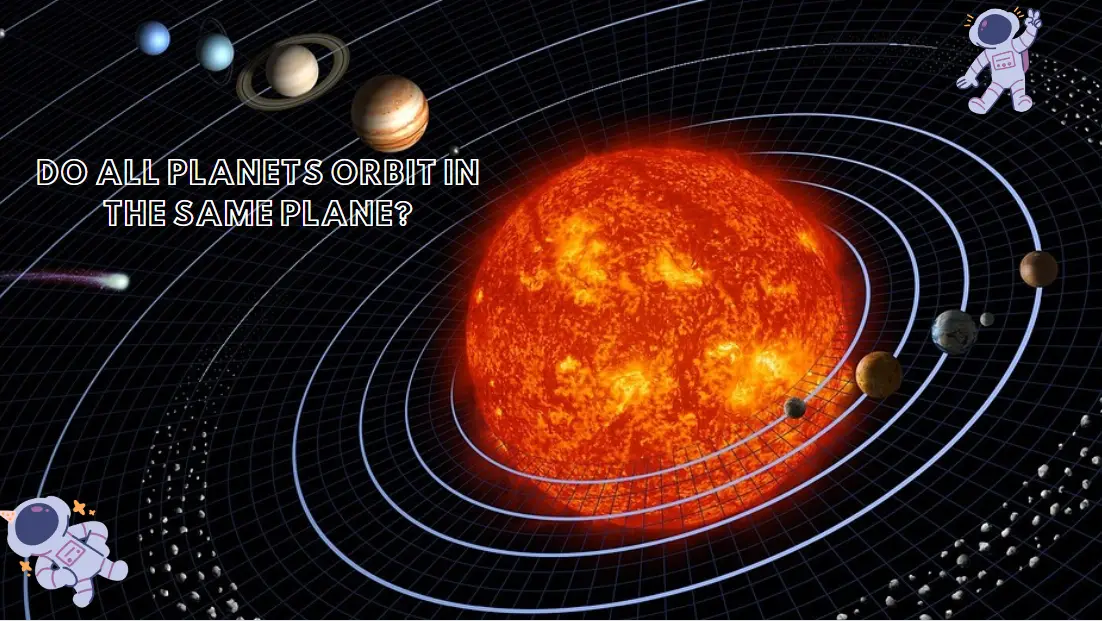We’ve all learned in school that the solar system has nine planets, plus a few dwarf planets in the Kuiper Belt and Oort Cloud. But did you know that those nine planets orbit around the Sun in the same plane? From Earth, we can only see five of the planets, but our telescopes have revealed that all of them have orbits within roughly 5 degrees of each other and about 10 to 20 degrees above or below the plane of Earth’s orbit. So why do all the planets orbit around the Sun in the same plane? That’s what we’re going to find out today!
What is a planet?
A planet is a celestial body that orbits a star. They are also classified as rocky, gaseous or icy. Depending on their composition, they may be classified as terrestrial or gas giants. Earth is an example of a terrestrial planet and Jupiter an example of a gas giant. The outermost layer of a planet (or asteroid) can tell you what type it is. Gases take up most of the volume inside gas giants, while there is more rock in terrestrials. All planets and asteroids have gravity, which is strong enough to pull things towards them. Some objects will also spin around them because they have not quite reached escape velocity – when an object tries to fly away from a planet but cannot because its gravitational pull is too strong.
The explanation for why all planets orbit in the same plane revolves around gravity. There are two forces at work here: the force of gravity pulling planets downwards, and the centrifugal force pulling them outwards. We’ll look at each one separately
What makes up an orbital plane
An orbital plane is an imaginary disc that divides space into two equal halves. The orbital planes of our solar system are perpendicular to the Earth’s equator and tilted at different angles, with some being more tilted than others. Each planet has its own unique orbital plane, which is determined by how it was formed and where it orbits. All these orbital planes combine and form a single flat disc called the ecliptic. If a solar system only contains one or two planets, their orbital plane will be close to horizontal because they’ll have less gravitational interference from other bodies. But when you have eight planets like ours, each with their own gravitational pull on one another, the orbital plane tilts as you get closer to the sun. Our planetary orbit is about 6 degrees off vertical compared to the Earth’s axis; for Mercury and Venus it’s about 10 degrees off vertical.
Understanding how orbits work can help explain how solar systems are formed.
All planetary orbits are elliptical, meaning they are not perfectly circular. As a planet travels around its orbit it has to overcome a gravitational force to continue traveling along its orbital path. This is known as centripetal acceleration. The strength of this force is determined by the distance between the planet and its parent star. The closer a planet is to its star, the stronger this force will be and vice versa. Since all planets are different distances from their stars, their centripetal forces will also differ. When these forces combine, an equilibrium point is reached where the gravitational pull from both objects cancels each other out and causes an orbit to form. These equilibrium points lie on a line which extends from the sun to each planet and forms what is called an ecliptic plane. For instance, Mercury’s orbit crosses over the Earth’s equator because it is so close to our sun while Neptune’s orbit crosses under ours because it is so far away.
As you can see, there are many factors that come into play when determining how orbits work. For instance, when a planet gets too close or too far away from its sun gravity plays less of a role than if it were at a more moderate distance.
A brief history of planetary orbits
Most of the time, when we say planets, we’re talking about the eight major ones: Mercury, Venus, Earth, Mars, Jupiter, Saturn, Uranus and Neptune. All of these planets have orbits that are approximately in a single plane. This is because they are all gravitationally attracted to one another and they tend to stay close together as they travel around their orbits. However, there are three notable exceptions. The planet Pluto has an orbital inclination of 17 degrees from the ecliptic (the path that follows the sun). Pluto’s orbit crosses those of other planets such as Neptune, which means it can get closer to or farther away from other planets than usual. Scientists think this is because Pluto was pulled into its current position by Neptune during planetary formation. Another exception is Mercury, which has an elliptical orbit. It sometimes gets closer to the sun than any other planet, but it also sometimes gets farther away from the sun than any other planet. Scientists don’t know for sure why this happens, but some possibilities are that perturbations in nearby masses might affect its orbit and/or tidal forces might be pulling on Mercury slightly differently than on Earth or Venus.
![]()
